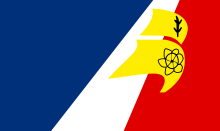Franco-Newfoundlander

Franco-Newfoundlanders, also known as Franco-Terreneuvians in English or Franco-Terreneuviens in French, are francophone and/or French Canadian residents of the Canadian province of Newfoundland and Labrador.[1] The name Franco-Terreneuvian derives from Terre-Neuve, the French name of Newfoundland.
The Franco-Newfoundlander community is most prominently associated with the Port au Port area near Stephenville, in communities such as Trois-Cailloux, Cap-Saint-Georges, La Grand'Terre, L'Anse-aux-Canards and Maisons-d'Hiver.[1] This region is unique as the only area in the province that is officially designated by provincial law as a bilingual district. However, francophone communities are also present throughout the province, particularly in St. John's, Labrador City and Happy Valley-Goose Bay.[2]
Newfoundland and Labrador's francophone community and its culture derive from a unique mix of influences and immigrants from Quebec, Acadia, St. Pierre and Miquelon, Brittany and the Basque Country, much of it predating Newfoundland's admission as a Canadian province in 1949.[3] Some aspects of the community's unique culture, however, have been lost or threatened as the community became more closely integrated into the mainstream of French Canadian culture and society after 1949.[4]
Flag
The Franco-Newfoundlander flag is based on the French tricolour and Acadian flag, with three unequal panels of blue, white, and red. Two yellow sails are set on the line between the white and red panels. The sail on top is charged with a spruce twig, while the bottom sail is charged with a pitcher flower. These emblems are outlined in black.
The sails represent early Basque, Breton, and French fishermen that came to the area in 1504. At the same time, they are symbols of action and progress. The yellow is taken from the star of the Acadian flag. The spruce twig is the emblem of Labrador and is also found on the Labrador flag. Newfoundland and Labrador's provincial flower is the insect-eating pitcher plant.
Language
Historically, Franco-Newfoundlanders were associated with the distinct Newfoundland French dialect. However, that dialect is now endangered, and most francophones in the province now speak either Acadian French, due to the influence of the Maritime Provinces, or Quebec French, which is the primary dialect of French instruction in schools.
The majority of Franco-Newfoundlanders, however, live their day-to-day lives partially or predominantly in English, due to their status as a small minority in a primarily anglophone province. In the Canada 2006 Census, just 650 people in the entire province identified themselves as being exclusively French-speaking,[5] while 30,545 identified themselves as being of at least partial French descent.[6]
The Port au Port region's current representative in the Newfoundland and Labrador House of Assembly, Tony Cornect, became the first MHA in the province ever to take his oath in French when he was sworn into office in 2007.[7]
Media
Radio-Canada serves the province through rebroadcasters of its stations in other provinces, and does not originate any radio or television programming in Newfoundland and Labrador. CBAFT, Télévision de Radio-Canada's station in Moncton, New Brunswick, airs on transmitters in St. John's, Port au Port, Labrador City and Churchill Falls. CBAF-FM-5, Première Chaîne's station in Halifax, Nova Scotia, has transmitters in St. John's and Port au Port, while Labrador City and Churchill Falls receive the service from CBSI-FM in Sept-Îles, Quebec. CBAX-FM, Espace musique's station in Halifax, has a rebroadcaster in St. John's.
The only francophone radio or television service which originates programming in the province is CJRM-FM, a community radio station in Labrador City. In 2009, that station applied to the CRTC to add rebroadcasters in La Grand'Terre and St. John's.[8]
A provincewide francophone newspaper, Le Gaboteur, is published in St. John's.[9]
Culture
The community's main political and social organization is the Fédération des Francophones de Terre-Neuve et du Labrador.
One of the most famous francophone Newfoundlanders was Émile Benoît, a fiddler from L'Anse-aux-Canards.[10]
Great Big Sea, a popular folk rock band from Newfoundland, included a cover of "Trois navires de blé", a traditional folk song associated with the francophone community of Port au Port, on their 1999 album Turn. Figgy Duff also recorded a number of French folk songs associated with the community, including "Quand j'étais fille à l'âge quinze ans" on their 1980 album Figgy Duff and "Dans la prison de Londres" on their 1982 album After the Tempest, as well as a song titled for Benoît, "Emile's Reels". A volume of Franco-Newfoundlander folk songs, Songs Sung by French Newfoundlanders, was published by Memorial University of Newfoundland in 1978.[11]
Other notable Franco-Newfoundlanders
- Claude Barrat
- Émile Benoît, musician
- Tony Cornect, politician
- Francois-Gabriel D'Angeac (or Dangeac, Danjaique, Don Jaque), governor
- Danny Dumaresque, politician
References
- ↑ 1.0 1.1 "Port-au-Port Peninsula". Newfoundland and Labrador Heritage.
- ↑ Modern Francophones. Newfoundland and Labrador Heritage.
- ↑ French Settlement. Newfoundland and Labrador Heritage.
- ↑ Gerald Thomas, The Two Traditions: The Art of Storytelling amongst French Newfoundlanders. Breakwater Press, 1993.
- ↑ Population by language spoken most often at home and age groups, 2006 counts, for Canada, provinces and territories.
- ↑ Ethnic origins, 2006 counts, for Canada, provinces and territories.
- ↑ "Port au Port MHA pledges oath in French". cbc.ca, March 5, 2007.
- ↑ Broadcasting Notice of Consultation CRTC 2009-431
- ↑ Le Gaboteur
- ↑ Émile Benoît. Newfoundland and Labrador Heritage.
- ↑ Franco-Canadian Folk Music. The Canadian Encyclopedia.